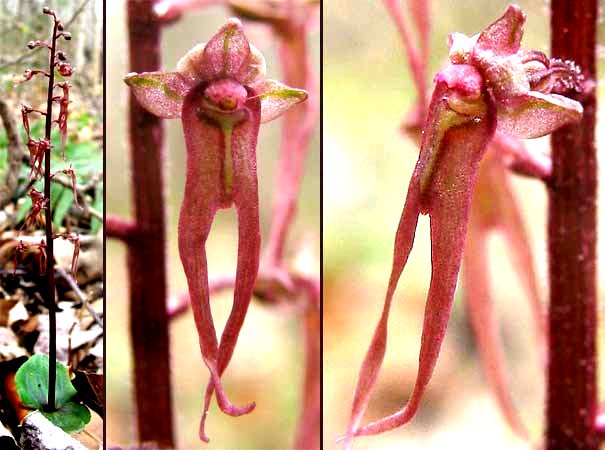Excerpts from Jim Conrad's
Naturalist Newsletter

from the the March 2, 2009 Newsletter, issued from the forest near Natchez, Mississippi; elevation ~400ft (120m), ~N31.47°, ~W91.29°:
TWAYBLADE ORCHID FLOWERING
Fairly common emerging from the dry leaf litter of pine/oak woods around here is the little orchid shown above.
That's the Southern Twayblade, LISTERA AUSTRALIS*, and most people -- even those spending a lot of time in the forest -- never notice it because it's so small and blends so well into the jumble of leaf litter around it. The visible part of the plant consists of two oval, thumbnail-size, cotyledon-like leaves topped by a four-inch-tall, raceme-type flower cluster. In the flower pictures the two-pronged, beardlike part of the corolla hanging down is the "lip" and it's only 0.4 inch long (10 mm).
In the picture's middle inset the yellowish T-shaped item at the lip's top is a nectary -- a nectar-producing gland. There's another at the base of the "column," or "gynostemium," which is the structure formed by the fused male and female parts, and the main thing making an orchid an orchid. In the pictures, it's the small lip extending outward directly above the yellow-T nectary.
When a pollinator visits the flower it touches trigger hairs on the column (there are four hairs). A dab of glue squirts onto the insect, tiny packets of fused pollen grains called pollinia are dropped onto the glue, and the insect flies off with the orchid flower's male pollinia glued to it. Ideally the pollinia are carried to the female part of another Southern Twayblade's column.
Often an orchid flower's strange form and color can be explained in terms of the flower looking look like a particular female insect, so that when a male comes along and tries to mate he pollinates the flower instead. That doesn't seem to be the case with Southern Twayblades, the main evidence being that the nectaries are easily accessible by many kinds of insects. The nectar is said to be fetid-smelling, being particularly attractive to insects such as fungus gnats and tiny flies.
The Orchid Family, the Orchidaceae, is the largest of all flowering plant, or angiosperm, families. In this area where members of the Grass and Composite Families are so abundant, and orchids are generally overlooked, most people find that hard to believe. However, once you see how common they are in the tropics, and how many habitats they occupy, you become a believer.
Southern Twayblades are distributed throughout the US Deep South, plus they exist in New York and adjacent Canada. This is a curious distribution pattern causing me to think that there may be two distinct but identical-looking species. Moreover, most literature I've seen describes the species as living in low, moist woods, marshes and sphagnum bogs and preferring acid soil, but here they definitely live in our dry, loess-covered uplands where the soil isn't at all acidic.
Whatever the case, what a pleasure to see this little orchid pop up so early in the spring. Back in my hermit days near here I reported on finding Southern Twayblades flowering just a week after we'd endured temperatures of 17°F (-8.3°C). Twayblades may look delicate but they're obviously tough little things.